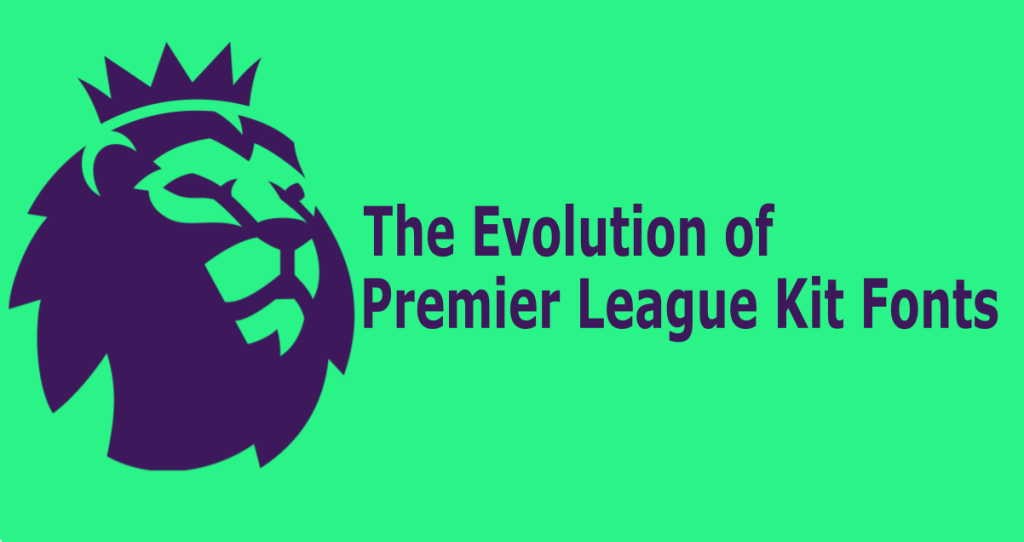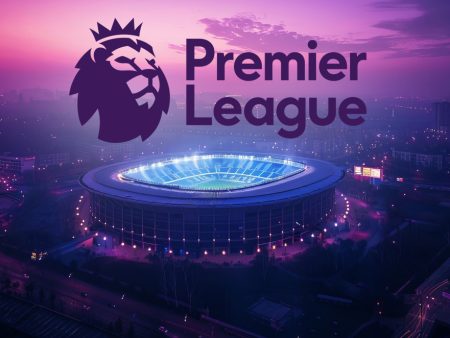
Football is not just a sport, but a cultural phenomenon that captivates millions of fans worldwide. Every element of the game, from the players and the stadiums to the kits they wear, is carefully crafted to enhance the overall experience for both the players and the spectators. One of the key components of a football kit is the font used for the player names and numbers, which has undergone a fascinating evolution in the history of the Premier League.

What is the Premier League font?
Overview and significance
The Premier League font refers to the specific typeface used for the printing of player names and numbers on Premier League kits. It is an integral part of the league’s branding strategy and plays a crucial role in distinguishing the Premier League from other football leagues around the world.
Changes over the years
Since the inception of the Premier League in 1992, the font used on the kits has evolved significantly. The early years saw a simple and classic font being used, but as the league grew in popularity, there was a need to create a more distinctive and modern look. The font went through several redesigns, incorporating different styles and elements to reflect the changing times and capture the essence of the Premier League.
Collaborations with suppliers
The Premier League works closely with its suppliers, such as Avery Dennison, to develop and implement the new font designs. These collaborations ensure that the font meets the league’s standards and aligns with its brand identity. The suppliers bring their expertise and experience to create new names and numbers that are not only visually appealing but also durable and functional.
Why do Premier League kits have different fonts?
Marketing and branding purposes
The use of different fonts on Premier League kits serves marketing and branding purposes. Each season, the introduction of a new font design creates excitement and anticipation among fans, reinforcing the Premier League’s position as a trendsetter in the world of football. It also helps to maintain the league’s image as a dynamic and evolving brand.
Increasing visibility on the field
The font design plays a crucial role in enhancing the visibility of player names and numbers on the field. The use of bold and clear fonts makes it easier for spectators, both in stadiums and at home, to identify and follow their favorite players during a match. This improves the overall viewing experience and adds to the spectacle of the game.
Meeting sponsor requirements
In some cases, the font design is influenced by the requirements of sponsors. Sponsors often have specific guidelines and demands regarding their logo placement and visibility on the kit. The font design needs to accommodate these requirements while still maintaining the overall aesthetic appeal and functionality.
How often does the Premier League font change?
Regular updates and redesigns
The Premier League font undergoes regular updates and redesigns to keep up with the ever-changing trends in design and technology. Each new season introduces a fresh look, injecting innovation and creativity into the kits. This constant evolution ensures that the Premier League remains at the forefront of kit design in the football world.
The introduction of new fonts
Over the years, the Premier League has introduced several new fonts that have become iconic in their own right. From the bold and impactful typefaces to the sleek and modern designs, each new font brings a unique personality to the league. These new fonts are eagerly anticipated by fans and often become cherished symbols of the season they represent.
The fourth time in Premier League history
In the 2023-24 season, the Premier League unveiled its latest font design, marking the fourth time in the league’s history that a new font was introduced. This new font not only incorporates the Premier League logo but also aims to improve readability on TV and in stadiums. The font features a clear and legible design, making it easier for viewers to identify and follow players in the fast-paced action of a football match.
What are the challenges in implementing new fonts?
Ensuring consistency across all clubs
One of the major challenges in implementing new fonts is ensuring consistency across all Premier League clubs. Each club has its own unique kit design and brand identity, which needs to be taken into consideration when designing and implementing the new font. It requires close collaboration between the league, the suppliers, and the clubs to ensure that the font maintains a consistent look while still reflecting the individuality of each club.
Managing supplier relationships
The Premier League works closely with its suppliers, such as Avery Dennison, to develop and produce the new font designs. Building and maintaining strong supplier relationships is essential to ensure the timely delivery of high-quality fonts that meet the league’s specifications. Effective communication and collaboration are key to successfully implementing the new fonts.
The role of the Chief Commercial Officer
The Chief Commercial Officer of the Premier League plays a crucial role in the implementation of new fonts. They oversee the strategic planning and execution of the league’s branding and marketing initiatives, including the development and deployment of the new fonts. Their expertise and experience in brand management are instrumental in ensuring that the new fonts align with the league’s overall brand strategy.
Full Premier League Kit Font History
It’s amazing how much the Premier League’s kit design has changed over the years, from the fonts and colors used to the branding and overall look. It’s a fascinating story, and in this article we’re going to look at the full history of Premier League kit fonts. We’ll explore the fonts used in the early 90s, the 2000s, the 2010s, and now in the 2020s, as well as the branding and design trends that have emerged over the years. So, let’s get started and take a look at how the Premier League’s kit fonts have evolved.
Early 1990s Fonts
In the early ’90s, Premier League kits featured bold, eye-catching fonts, w/ sharp, angular lines that really stood out. Teams such as Manchester United & Arsenal had logos that featured block-style lettering, while Chelsea’s logo had a more rounded, curved design. The Liverpool logo included a crest, along w/ the team name, each in contrasting colors.
Other teams, such as Leeds United & Tottenham Hotspur, adopted more modern fonts, which saw the introduction of thinner & more symmetrical lines. The overall effect was one of vibrancy & modernity. These fonts captured the energy & personality of the league & its clubs, & remain popular to this day.
2000s Fonts
Throughout the ’00s, bold font designs dominated Premier League kits, making a statement on the pitch. Fonts of this era featured creative lettering, often with sharp angles or exaggerated curves. Liverpool’s kit featured a unique font, with letters that resembled the shape of a Liverbird. Arsenal’s font was also unique, featuring a mix of capital and lowercase letters.
Manchester United’s font was the most iconic of the decade, with a red, white, and black color scheme. This font was featured on the team’s jerseys for multiple seasons. Other teams, such as Newcastle United and Chelsea, used a standard font throughout the decade. Despite the standard font, each team still managed to make a statement with their jerseys. The ’00s saw a major shift in font designs, with teams showing more personality and creativity in their designs.
2010s Fonts
The ’00s saw a major transformation of font designs, with teams taking on more distinct and daring designs to make a statement. Many Premier League clubs opted for a bolder, cleaner look, with sharp, modern fonts replacing the traditional serifs of the past.
Chelsea had an angular typeface that was used for the first time in 2002, while Manchester United took the bold step of introducing a new font in 2003. Arsenal also adopted a more modern look in 2004, with a classic sans-serif font, while Liverpool and Newcastle United went for a more traditional look. The ’00s saw more creativity in font design, with clubs taking on unique and creative designs that helped them stand out from the crowd.
2020s Fonts
You’ll be sure to recognize the iconic ’00s fonts, as teams embraced a more daring and unique design to make a statement. From Arsenal’s classic ‘Highbury’ font to Tottenham Hotspur’s ‘Spurs’ font, the Premier League saw a shift in design throughout the decade. Manchester United continued to use their ‘Adidas’ font, while Liverpool shifted to a more modern font that was used during their Champions League run in 2005. Chelsea adopted a unique font for the 2003-04 season, featuring a bold ‘C’ logo in the middle.
Arsenal’s font changed twice during the decade, the first being ‘Highbury’ in 2000-01 and then a more modern version for the 2003-04 season. The club has since continued to use this font. Tottenham Hotspur’s ‘Spurs’ font was used for the entire decade, with the club using a similar font from 2002-03. The Premier League saw a shift in font throughout the decade, with teams embracing a more daring and unique design to make a statement. The iconic ’00s fonts continue to be recognized to this day.
Branding and Design Trends
With teams looking to make a statement, the 2010s saw a shift in branding and design trends across the Premier League. Teams sought to stand out from the competition and attract new fans, leading to a more modern and stylish approach to kit design. This included bolder color schemes, often with brighter shades and a focus on smaller details.
Fonts also saw a dramatic change, with teams opting for more modern styles such as sans serif fonts and geometric shapes. These were often accompanied by unique symbols and logos, creating a more distinctive look for each team’s kit. As a result, the Premier League has seen a greater variety of fonts and design trends in recent years, giving each team a unique identity and badge.
Conclusion of the Full Premier League Kit History
Over the decades, the Premier League has seen a variety of kit font designs, ranging from classic serifs to bold sans-serifs, with trends changing to reflect the times. From the early 1990s to the present day, the fonts used on Premier League kits have evolved to keep up with the ever-changing world of branding and design. Whether it’s a well-known logo or a custom font, the Premier League has managed to keep up with the times, creating a unique and recognisable identity that will stand the test of time.









